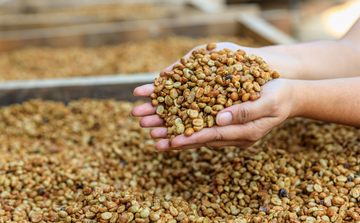
Discover Honey processed Coffee
The name of this process may mislead many to think that honey is used at some point in the harvesting, drying, or roasting. However, there is no use of honey in this coffee process. The term Honey is used for the color of the coffee seeds at the end of this processing method. There are two traditional ways of coffee processing, a wet process, and a dry process. The wet process involves wetting the coffee beans and allowing them to ferment. The wet process is more efficient than the dry process as the wetting and fermentation expedite the drying step. The drying process is harder to control, as it depends on the cooperation of environmental factors like climate, for the coffee beans to fully dry. Between these two traditional process methods is the honey process. The honey process prioritizes the sweet and fruitful flavors by maintaining the sticky sugary layer that surrounds the bean rather than washing it away.

Step 1. Harvesting and Pulping

No matter what process a farmer is choosing to use to create their coffee beans, the first step will always be harvesting the coffee cherries. Coffee cherries are harvested once a year, however, the timing of this harvest varies depending on the region and altitude of the plant. Farmers must hand-pick each one when harvesting coffee cherries, making sure to only choose those at peak ripeness. After harvest each coffee cherry is carefully washed to remove any dirt without damaging the cherry. From washing, the cherries are then taken to have all the pulp removed leaving only the bean. Farmers do this by feeding the cherries through a special pulping machine.
Step 2. Mucilage Retention

Once the cherries have been harvested and pulped it is time for the step that differentiates the honey process from any other coffee processing method which is the practice of Mucilage retention. Mucilage is a sticky sugary layer that surrounds the coffee bean inside the cherry. While most processes would fully remove the layer of mucilage by wetting and washing the beans. However the honey process keeps a portion of the mucilage layer on the bean, this is what creates the sweeter honey notes in your cup.
Step 3. Drying and Fermentation

With the desired layer of mucilage remaining on the beans, it is time to begin drying. Large beds or patios are covered in the washed beans to allow for drying. While the beans are drying, fermentation brings, this is similar to the wet coffee process, where the drying process is sped up by fermentation. While the beans may simply be lying in the sun they still require lots of attention as they must be turned regularly to ensure proper drying on both sides and avoid mold or spoilage. Depending on climate conditions, drying time can range from a couple of days to a few weeks.
Step 4. Milling and storage

The coffee beans have been dried they are now referred to as green beans. The green beans are sorted based on density size and shape, then graded based on their quality and characteristics such as tasting notes and flavours. It is now time for the beans to undergo the milling process which removes the parchment skin of the bean, followed by sorting to remove any remaining defects or impurities. Farmers are then asked with the final step of finding a cool and dry place to store the beans until they are ready to be roasted.
Different Type Honey Process Coffees

There are three different types of honey-processed coffees, Yellow Honey, red honey, and black honey. Yellow honey is in which the de-pulped coffee seed is placed directly onto a drying bed and is dried for 8 days, leaving the seed to turn a yellow-gold honey color naturally. It has a milder fruity flavor. Red honey and black honey are placed under a partially covered tarp, where the coffee seeds rest together in mountain-like shapes for some time, to achieve a more complex and fermented taste, and then laid flat on the drying bed. The red honey is left for approximately 12 days, during which the seeds turn into a red/brown color. The black honey process is the longest trying process where the coffee seeds are dried for up to 30 days with the most amount of pulp left on the seed, transforming the color of the seed to a darker, almost blackish color.
